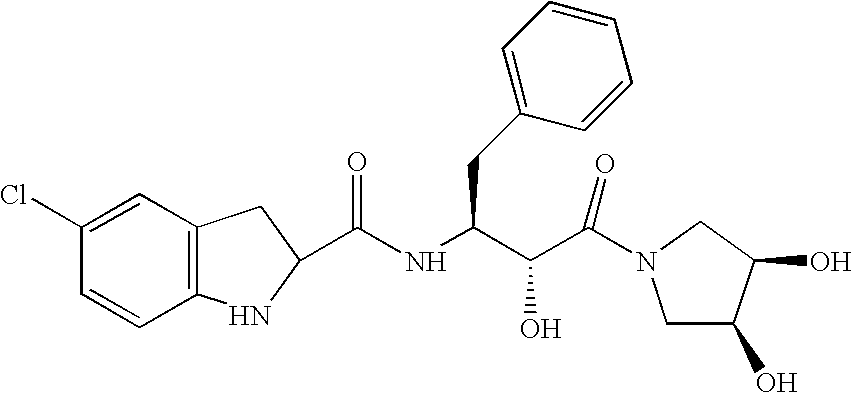Pharmaceutical compositions of a sparingly soluble glycogen phosphorylase inhibitor
a glycogen phosphorylase inhibitor and composition technology, applied in the direction of drug compositions, biocide, metabolic disorders, etc., can solve the problems of low c/sub>max /sub> of drug a in blood plasma, low auc, etc., and achieve the effect of enhancing the aqueous concentration
- Summary
- Abstract
- Description
- Claims
- Application Information
AI Technical Summary
Benefits of technology
Problems solved by technology
Method used
Image
Examples
example 1
[0205]An amorphous solid dispersion of 25 wt % Drug A and 75 wt % polymer was made by first mixing Drug A in the solvent acetone together with a finely powdered “MF” grade of the cellulosic polymer HPMCAS (AQUOT-MF, Shin-Etsu Chemical Co., Ltd., Tokyo, Japan) to form a solution. The solution comprised 1.25 wt % Drug A, 3.75 wt % HPMCAS-MF, and 95 wt % acetone. This solution was then spray-dried by directing an atomizing spray via a 2-fluid external mix spray nozzle at 2.6 bar (37 psig) at a 175 to 180 g / min feed rate into a stainless steel chamber of a NIRO XP spray drier, maintained at a temperature of 180° C. at the inlet and 69° at the outlet.
[0206]The resulting amorphous solid dispersion was collected via a cyclone and then dried in a Gruenberg solvent tray dryer by spreading the spray-dried particles onto polyethylene-lined trays to a depth of a little less than 1 cm, and then drying them at 40° C. for 8 hours.
example 2
[0207]An amorphous solid dispersion was prepared as in Example 1 except that the dispersion was prepared by a NIRO PSD-1 spray-dryer using the same operating parameters as in Example 1, and the dispersion contained 50 wt % Drug A and 50 wt % HPMCAS-MF and the spray solution comprised 1.25 wt % Drug A, 1.25 wt % HPMCAS-MF, 97.5 wt % acetone.
examples 3 – 7
EXAMPLES 3–7
[0208]Amorphous solid dispersions were prepared following the procedure of Example 1 except that a “mini” spray-dryer was used and the polymers used for the dispersions were HPMC, PVP, CAP, CAT and HPMCP, respectively. The “mini” spray dryer, consisted of an atomizer in the top cap of a vertically oriented stainless steel pipe. The atomizer was a two-fluid nozzle (Spraying Systems Co. 1650 fluid cap and 64 air cap) where the atomizing gas was nitrogen delivered to the nozzle at 100° C. and a flux of 15 gm / min, and the test solution to be spray dried was delivered to the nozzle at room temperature and a flow rate of 1 gm / min using a syringe pump. Filter paper with a supporting screen was clamped to the bottom end of the pipe to collect the solid spray-dried material and allow the nitrogen and evaporated solvent to escape.
PUM
| Property | Measurement | Unit |
|---|---|---|
| aqueous solubility | aaaaa | aaaaa |
| solubility | aaaaa | aaaaa |
| solubility | aaaaa | aaaaa |
Abstract
Description
Claims
Application Information
 Login to View More
Login to View More - R&D
- Intellectual Property
- Life Sciences
- Materials
- Tech Scout
- Unparalleled Data Quality
- Higher Quality Content
- 60% Fewer Hallucinations
Browse by: Latest US Patents, China's latest patents, Technical Efficacy Thesaurus, Application Domain, Technology Topic, Popular Technical Reports.
© 2025 PatSnap. All rights reserved.Legal|Privacy policy|Modern Slavery Act Transparency Statement|Sitemap|About US| Contact US: help@patsnap.com

